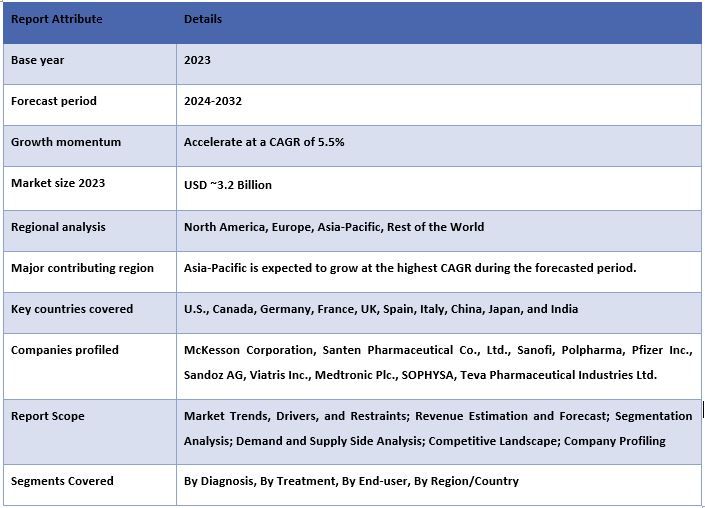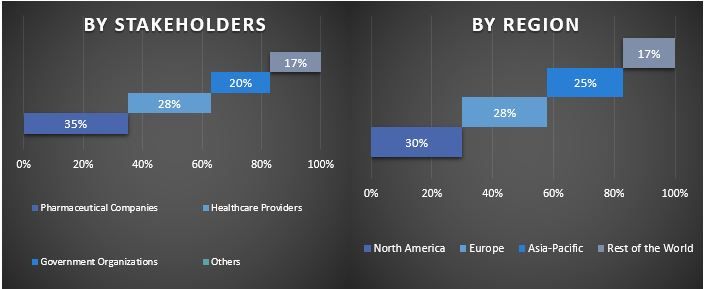- Inicio
- Acerca de nosotros
- Industria
- Servicios
- Leyendo
- Contáctenos
Mercado de pseudotumor cerebral: Análisis actual y pronóstico (2024-2032)
Énfasis en el Diagnóstico (Fondo de ojo, Neuroimagen, Punción Lumbar y Otros), Tratamiento (Derivación de Líquido Cefalorraquídeo, Fenestración de la Vaina del Nervio Óptico, Stenting del Seno Venoso y Medicación), Usuario Final (Hospitales, Clínicas y Otros); y Región/País
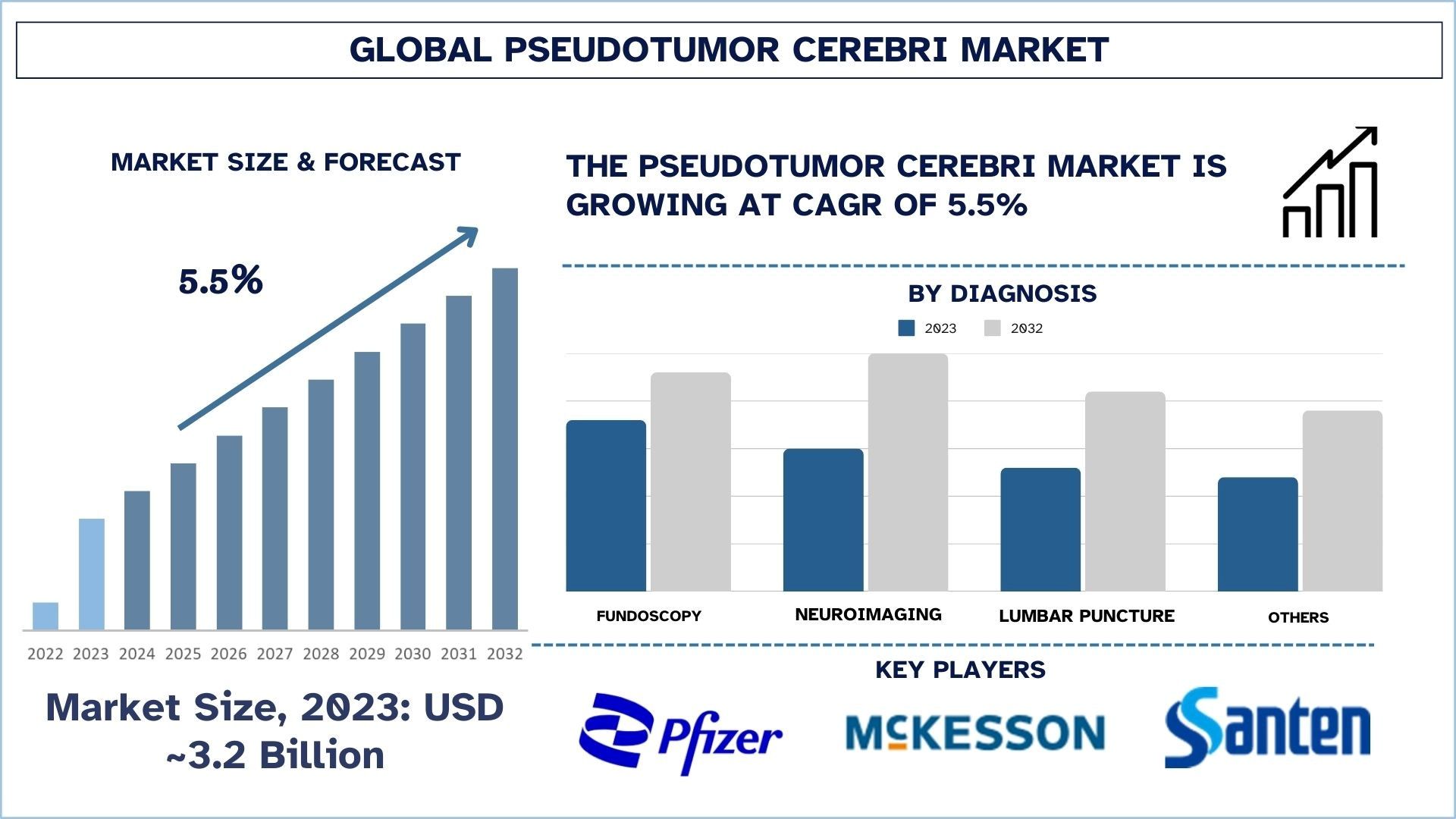
Tamaño y pronóstico del mercado de pseudotumor cerebri
El mercado de pseudotumor cerebri se valoró en aproximadamente USD ~3200 millones en 2023 y se espera que crezca a una TCAC sustancial de alrededor del 5,5% durante el período de pronóstico (2024-2032) debido a la creciente prevalencia de la obesidad, que es un factor de riesgo importante para desarrollar pseudotumor cerebri, junto con los avances tecnológicos en el sector de diagnóstico.
Análisis del mercado de pseudotumor cerebri
El pseudotumor cerebri, también conocido como hipertensión intracraneal idiopática (HII), es un trastorno neurológico en el que la presión que rodea el cerebro y la médula espinal (presión intracraneal) es más alta de lo normal, pero no hay inflamación, infección, tumor u otras afecciones que puedan explicar este aumento. Esta condición es más frecuente en mujeres embarazadas y mujeres en edad fértil con exceso de peso corporal u obesidad. La etiología exacta aún no se ha determinado, aunque es probable que esté relacionada con un mal funcionamiento en la regulación del LCR. Los primeros síntomas suelen ser dolores de cabeza crónicos y cambios en la visión, por ejemplo, visión borrosa, diplopía o pérdida temporal de la visión, tinnitus pulsátil y papiledema por aumento de la presión intracraneal. Si no se trata, puede provocar ceguera permanente. El diagnóstico consiste en un examen y evaluación clínicos, imágenes cerebrales para descartar otras posibilidades patológicas y la obtención de la presión del LCR mediante una punción lumbar. El tratamiento implica una reducción de la presión intracraneal, para lo cual se puede recomendar a algunos pacientes que bajen de peso, tomen medicamentos, en particular acetazolamida, se sometan a una fenestración de la vaina del nervio óptico o se utilice una derivación de líquido cefalorraquídeo si la afección se vuelve extrema.
El mercado de pseudotumor cerebri está impulsado principalmente por el aumento de la incidencia de obesidad, que es una de las principales causas de pseudotumor cerebri, especialmente entre las mujeres en edad fértil. El aumento de la concienciación y la mejora de las soluciones de diagnóstico, como las soluciones de imagen y las soluciones de punción lumbar, son los factores que impulsan el mercado de pseudotumor cerebri. El crecimiento del mercado se debe al aumento de la investigación de nuevos métodos de tratamiento, que pueden incluir invasiones mínimas, como operaciones quirúrgicas y terapias medicamentosas exitosas. Además, el aumento de los esfuerzos de los gobiernos para combatir los trastornos neurológicos y la investigación sobre la fisiopatología de la hipertensión intracraneal idiopática contribuyen al desarrollo de intervenciones terapéuticas, que continúan ampliando el potencial de mercado para el tratamiento de este trastorno.
Tendencias del mercado de pseudotumor cerebri
Esta sección analiza las principales tendencias del mercado que influyen en los diversos segmentos del mercado de pseudotumor cerebri identificadas por nuestros expertos en investigación.
Enfoque en soluciones no invasivas
El mercado de pseudotumor cerebri favorece los métodos de tratamiento menos invasivos para que los pacientes se sientan más cómodos, minimizando los riesgos y mejorando sus resultados. Los pacientes experimentan grandes cargas tanto por los aspectos físicos como emocionales al someterse a los tratamientos tradicionales para el pseudotumor cerebri, como la punción lumbar y las cirugías de derivación. La nueva tecnología médica promueve formas más seguras de brindar tratamiento a los pacientes mediante el uso de medicamentos y cirugías simples, como la apertura del nervio óptico, lo que ayuda a reducir la presión cerebral sin la necesidad de una cirugía mayor. Los dispositivos portátiles modernos y los equipos de monitorización no invasivos rastrean la presión intracraneal en tiempo real para ayudar a los médicos a brindar un mejor tratamiento de inmediato. El cambio hacia tratamientos no invasivos promueve la atención médica centrada en el paciente al tiempo que brinda a las empresas nuevas oportunidades para crear métodos más seguros para un mejor crecimiento del mercado.
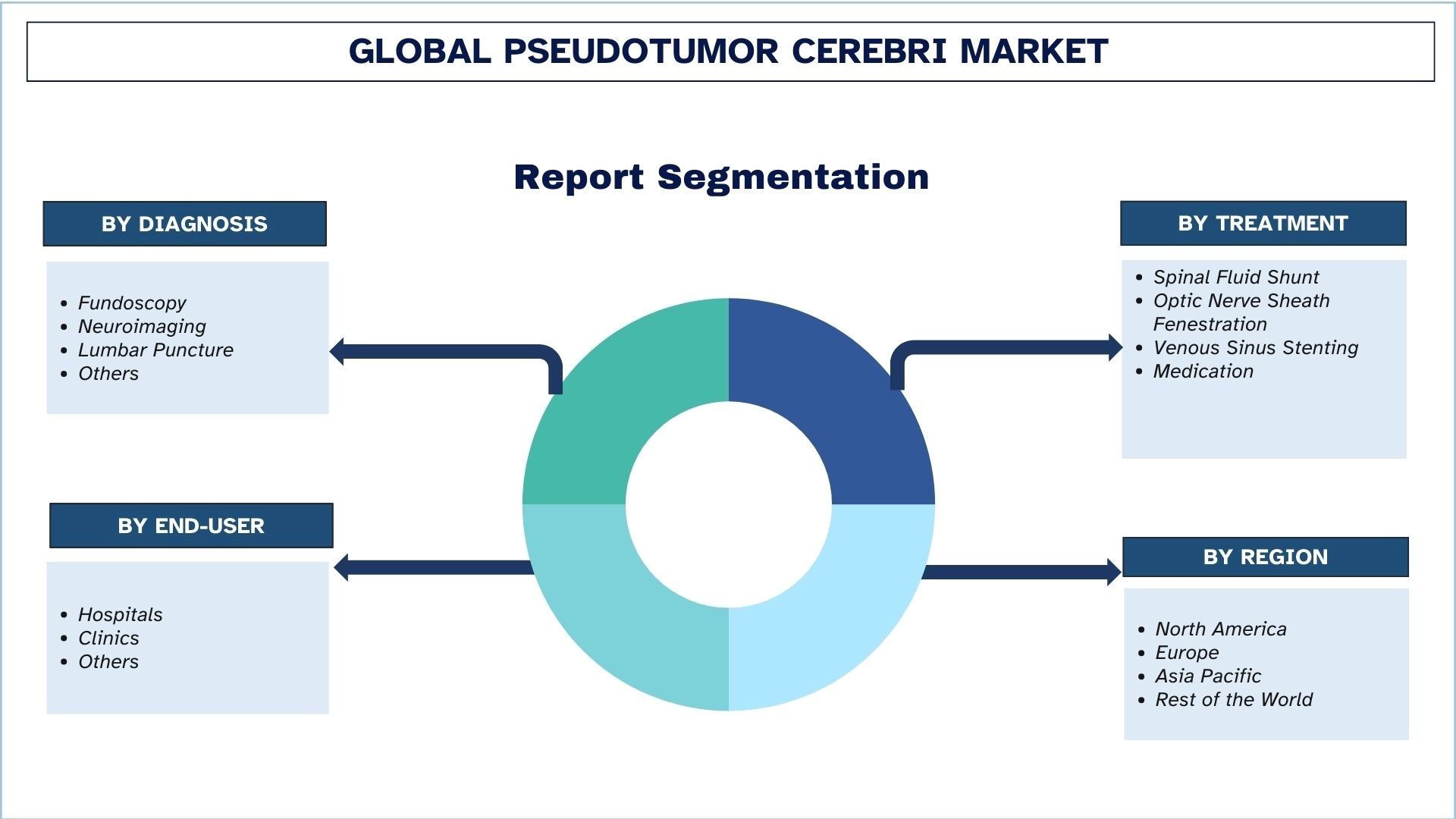
Se espera que Asia-Pacífico sea la región de más rápido crecimiento
El mercado de APAC muestra el crecimiento más rápido del pseudotumor cerebri debido a varios factores. Las fuertes inversiones en atención médica y las pruebas médicas avanzadas han mejorado la capacidad de encontrar y controlar mejor esta enfermedad, lo que ha llevado a una mayor conciencia de esta enfermedad en la región de APAC. Como la obesidad es un factor principal de esta enfermedad, las crecientes tasas de obesidad en China e India están impulsando la expansión del mercado en esta región. Los gobiernos y las empresas de atención médica de APAC invierten fuertemente en investigación científica para respaldar nuevas terapias médicas y, al mismo tiempo, permitir mejores soluciones de tratamiento. El turismo médico está creciendo en Tailandia y Malasia, ya que ofrecen servicios de atención médica asequibles y de calidad para los turistas. Los proveedores de atención médica y los proveedores de seguros están avanzando en la detección temprana y el tratamiento porque ahora comprenden mejor estas afecciones médicas. Tanto el fuerte crecimiento económico como las grandes bases de población en la región de APAC crean demanda de tratamientos eficaces para el pseudotumor cerebri.
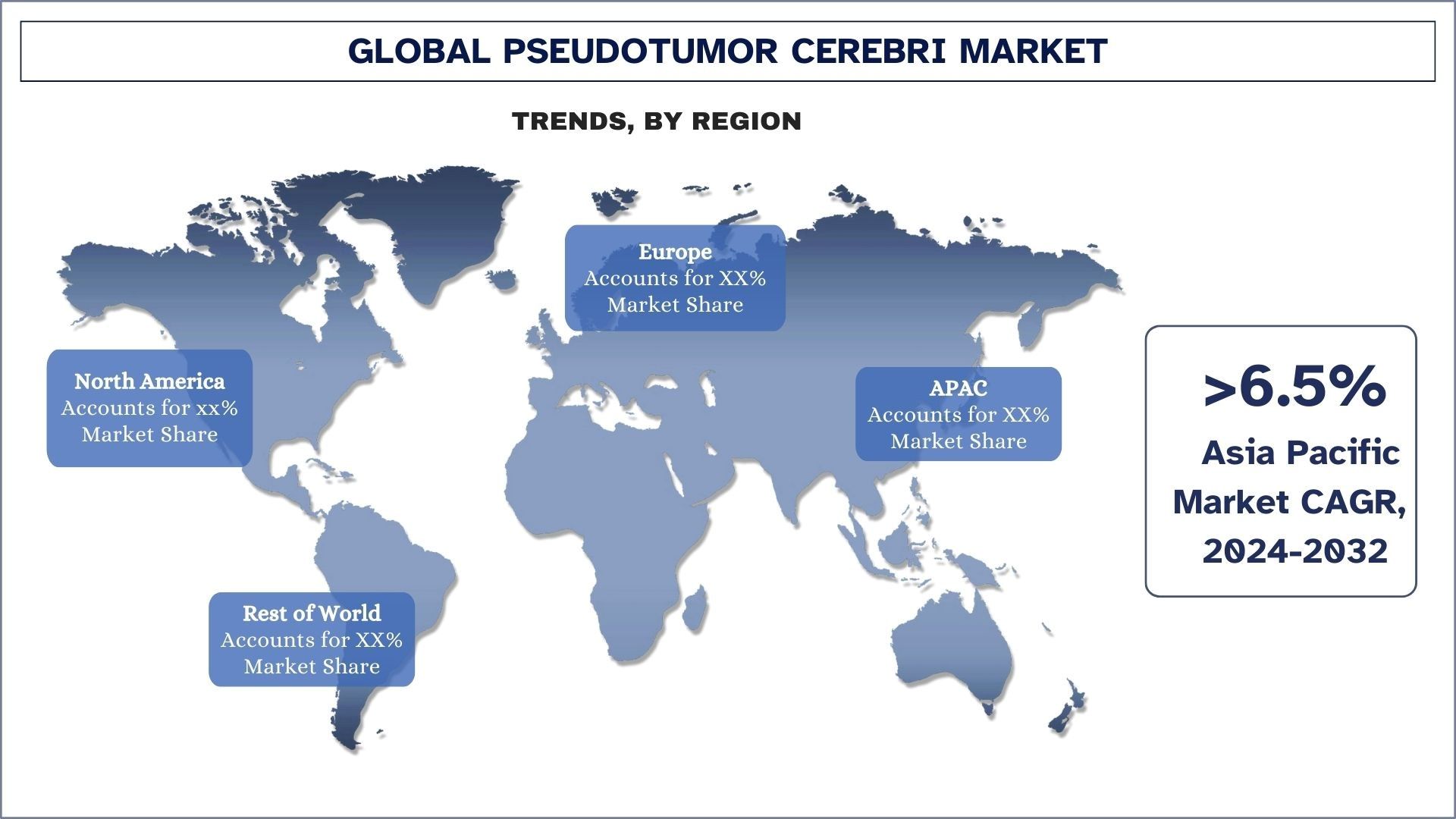
Descripción general de la industria del pseudotumor cerebri
El mercado de pseudotumor cerebri es competitivo, con varios actores globales e internacionales. Los actores clave están adoptando diferentes estrategias de crecimiento para mejorar su presencia en el mercado, como asociaciones, acuerdos, colaboraciones, lanzamientos de nuevos productos, expansiones geográficas y fusiones y adquisiciones. Algunos de los principales actores que operan en el mercado son McKesson Corporation, Santen Pharmaceutical Co., Ltd., Sanofi, Polpharma, Pfizer Inc., Sandoz AG, Viatris Inc., Medtronic Plc., SOPHYSA, Teva Pharmaceutical Industries Ltd.
Cobertura del informe de mercado de pseudotumor cerebri
Razones para comprar este informe:
El estudio incluye el análisis del tamaño del mercado y la previsión validados por expertos clave autenticados de la industria.
El informe presenta una revisión rápida del rendimiento general de la industria de un vistazo.
El informe cubre un análisis en profundidad de los pares prominentes de la industria con un enfoque principal en las finanzas comerciales clave, las carteras de productos, las estrategias de expansión y los desarrollos recientes.
Examen detallado de los impulsores, las restricciones, las tendencias clave y las oportunidades que prevalecen en la industria.
El estudio cubre de manera integral el mercado en diferentes segmentos.
Análisis profundo a nivel regional de la industria.
Opciones de personalización:
El mercado global de pseudotumor cerebri se puede personalizar aún más según los requisitos o cualquier otro segmento de mercado. Además de esto, UMI entiende que puede tener sus propias necesidades comerciales, por lo tanto, no dude en conectarse con nosotros para obtener un informe que se adapte completamente a sus requisitos.
Tabla de contenido
Metodología de investigación para el análisis del mercado de pseudotumor cerebri (2022-2032)
El análisis del mercado histórico, la estimación del mercado actual y la previsión del mercado futuro del mercado mundial de pseudotumor cerebri fueron los tres pasos principales que se llevaron a cabo para crear y analizar la adopción de pseudotumor cerebri en las principales regiones del mundo. Se llevó a cabo una exhaustiva investigación secundaria para recopilar las cifras históricas del mercado y estimar el tamaño actual del mercado. En segundo lugar, para validar estas perspectivas, se tomaron en consideración numerosos hallazgos y supuestos. Además, también se llevaron a cabo exhaustivas entrevistas primarias con expertos de la industria en toda la cadena de valor del mercado mundial de pseudotumor cerebri. Tras la suposición y validación de las cifras del mercado a través de entrevistas primarias, empleamos un enfoque de arriba hacia abajo/de abajo hacia arriba para pronosticar el tamaño completo del mercado. Posteriormente, se adoptaron métodos de desglose del mercado y triangulación de datos para estimar y analizar el tamaño del mercado de los segmentos y subsegmentos de la industria. La metodología detallada se explica a continuación:
Análisis del tamaño del mercado histórico
Paso 1: Estudio exhaustivo de fuentes secundarias:
Se llevó a cabo un estudio secundario detallado para obtener el tamaño histórico del mercado de pseudotumor cerebri a través de fuentes internas de la empresa, como informes anuales y estados financieros, presentaciones de resultados, comunicados de prensa, etc., y fuentes externas, como revistas, noticias y artículos, publicaciones gubernamentales, publicaciones de la competencia, informes del sector, bases de datos de terceros y otras publicaciones creíbles.
Paso 2: Segmentación del mercado:
Después de obtener el tamaño histórico del mercado de pseudotumor cerebri, realizamos un análisis secundario detallado para recopilar información histórica del mercado y compartirla para diferentes segmentos y subsegmentos para las principales regiones. Los principales segmentos incluidos en el informe son el diagnóstico, el tratamiento, el usuario final y las regiones. Además, se llevaron a cabo análisis a nivel de país para evaluar la adopción general de pseudotumor cerebri en esa región.
Paso 3: Análisis de factores:
Después de adquirir el tamaño histórico del mercado de diferentes segmentos y subsegmentos, llevamos a cabo un análisis de factores detallado para estimar el tamaño actual del mercado de pseudotumor cerebri. Además, realizamos un análisis de factores utilizando variables dependientes e independientes, como el diagnóstico, el tratamiento, el usuario final y las regiones del mercado de pseudotumor cerebri. Se llevó a cabo un análisis exhaustivo de los escenarios de la oferta y la demanda, teniendo en cuenta las principales asociaciones, fusiones y adquisiciones, la expansión comercial y los lanzamientos de productos en el mercado de pseudotumor cerebri en todo el mundo.
Estimación y previsión del tamaño actual del mercado
Tamaño actual del mercado: Basándonos en la información práctica de los 3 pasos anteriores, llegamos al tamaño actual del mercado, los actores clave en el mercado mundial de pseudotumor cerebri y las cuotas de mercado de los segmentos. Todos los porcentajes de participación, la división y el desglose del mercado necesarios se determinaron utilizando el enfoque secundario mencionado anteriormente y se verificaron a través de entrevistas primarias.
Estimación y previsión: Para la estimación y previsión del mercado, se asignaron ponderaciones a diferentes factores, incluidos los impulsores y las tendencias, las restricciones y las oportunidades disponibles para las partes interesadas. Después de analizar estos factores, se aplicaron las técnicas de previsión pertinentes, es decir, el enfoque de arriba hacia abajo/de abajo hacia arriba, para llegar a la previsión del mercado para 2032 para diferentes segmentos y subsegmentos en los principales mercados a nivel mundial. La metodología de investigación adoptada para estimar el tamaño del mercado abarca:
El tamaño del mercado de la industria, en términos de ingresos (USD) y la tasa de adopción del mercado de pseudotumor cerebri en los principales mercados a nivel nacional.
Todos los porcentajes de participación, la división y el desglose de los segmentos y subsegmentos del mercado.
Los actores clave en el mercado mundial de pseudotumor cerebri en términos de productos ofrecidos. Además, las estrategias de crecimiento adoptadas por estos actores para competir en el mercado de rápido crecimiento.
Validación del tamaño y la cuota de mercado
Investigación primaria: Se llevaron a cabo entrevistas en profundidad con los líderes de opinión clave (Key Opinion Leaders, KOL), incluidos los ejecutivos de alto nivel (CXO/VP, jefe de ventas, jefe de marketing, jefe de operaciones, jefe regional, jefe de país, etc.) en las principales regiones. Los hallazgos de la investigación primaria se resumieron y se realizó un análisis estadístico para demostrar la hipótesis establecida. Las aportaciones de la investigación primaria se consolidaron con los hallazgos secundarios, convirtiendo así la información en información práctica.
División de los participantes primarios en diferentes regiones
Ingeniería de mercado
Se empleó la técnica de triangulación de datos para completar la estimación general del mercado y para llegar a cifras estadísticas precisas para cada segmento y subsegmento del mercado mundial de pseudotumor cerebri. Los datos se dividieron en varios segmentos y subsegmentos después de estudiar varios parámetros y tendencias en el diagnóstico, el tratamiento, el usuario final y las regiones del mercado mundial de pseudotumor cerebri.
El objetivo principal del estudio del mercado mundial de pseudotumor cerebri
Las tendencias actuales y futuras del mercado mundial de pseudotumor cerebri se señalaron en el estudio. Los inversores pueden obtener información estratégica para basar su criterio para las inversiones en el análisis cualitativo y cuantitativo realizado en el estudio. Las tendencias actuales y futuras del mercado determinaron el atractivo general del mercado a nivel regional, proporcionando una plataforma para que el participante industrial explote el mercado sin explotar para beneficiarse de una ventaja de ser el primero en actuar. Otros objetivos cuantitativos de los estudios incluyen:
Analizar el tamaño actual y previsto del mercado de pseudotumor cerebri en términos de valor (USD). Además, analizar el tamaño actual y previsto del mercado de diferentes segmentos y subsegmentos.
Los segmentos del estudio incluyen áreas de diagnóstico, tratamiento, usuario final y regiones.
Definir y analizar el marco regulatorio para el pseudotumor cerebri
Analizar la cadena de valor involucrada con la presencia de varios intermediarios, junto con el análisis de los comportamientos de los clientes y la competencia de la industria.
Analizar el tamaño actual y previsto del mercado de pseudotumor cerebri para la región principal.
Los principales países de las regiones estudiadas en el informe incluyen Asia Pacífico, Europa, Norteamérica y el resto del mundo
Perfiles de las empresas del mercado de pseudotumor cerebri y las estrategias de crecimiento adoptadas por los actores del mercado para mantener el mercado de rápido crecimiento.
Análisis regional en profundidad de la industria.
Preguntas frecuentes Preguntas frecuentes
P1: ¿Cuál es el tamaño actual y el potencial de crecimiento del mercado de pseudotumor cerebri?
El mercado de pseudotumor cerebral se valoró en USD ~3.2 mil millones en 2023 y se espera que crezca a una CAGR del 5.5% durante el período de pronóstico (2024-2032).
P2: ¿Cuáles son los factores impulsores del crecimiento del mercado de pseudotumor cerebri?
El mercado de pseudotumor cerebri está impulsado principalmente por el aumento de la incidencia de la obesidad, la creciente concienciación y la mejora de las soluciones de diagnóstico, como las soluciones de imagen y las soluciones de punción lumbar.
P3: ¿Qué segmento tiene la mayor cuota del mercado de pseudotumor cerebri por diagnóstico?
El segmento de neuroimagen tiene la mayor cuota de mercado de pseudotumor cerebri por diagnóstico.
P4: ¿Cuáles son las principales tendencias en el mercado del pseudotumor cerebri?
Las principales tendencias en el mercado del pseudotumor cerebri son el enfoque en soluciones no invasivas y la integración de la IA en el diagnóstico.
P5: ¿Qué región dominará el mercado de pseudotumor cerebri?
Norteamérica dominó el mercado en 2023.
Relacionados Informes
Los clientes que compraron este artículo también compraron

